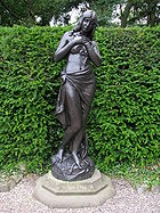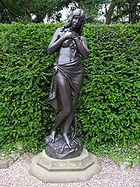
Andrea Carlo Lucchesi
Encyclopedia

New Sculpture
The New Sculpture refers to a movement in late 19th-century British sculpture.The term "New Sculpture" was coined by the first historian of the movement, the critic Edmund Gosse, who wrote a four-part series for the Art Journal in 1894...
". His portrait of Queen Victoria is on the facade of the Art Gallery, at Bath.
Lucchesi received his early training from his father, also a sculptor, and at the West London School of Art; he first exhibited at the Royal Academy
Royal Academy
The Royal Academy of Arts is an art institution based in Burlington House on Piccadilly, London. The Royal Academy of Arts has a unique position in being an independent, privately funded institution led by eminent artists and architects whose purpose is to promote the creation, enjoyment and...
in 1881. In 1882 his Waif won him acceptance at the Royal Academy schools, where he remained five years (1881-86). He was a member of the Art Workers Guild
Art Workers Guild
The Art Workers Guild or Art-Workers' Guild is an organisation established in 1884 by a group of British architects associated with the ideas of William Morris and the Arts and Crafts movement. The guild promoted the 'unity of all the arts', denying the distinction between fine and applied art...
, established in 1884 to promote the "unity of the arts"
Lucchesi specialised in the female nude, naturalistically represented under allegorical titles, such as Destiny and the undisguisedly erotic Myrtle's Altar (1899), manifesting clear influences of Art Nouveau
Art Nouveau
Art Nouveau is an international philosophy and style of art, architecture and applied art—especially the decorative arts—that were most popular during 1890–1910. The name "Art Nouveau" is French for "new art"...
and, in the finely modelled symbolic representations of crown, sword, spilled bag of coins, of Symbolism
Symbolism (arts)
Symbolism was a late nineteenth-century art movement of French, Russian and Belgian origin in poetry and other arts. In literature, the style had its beginnings with the publication Les Fleurs du mal by Charles Baudelaire...
. In addition to his own work, he assisted Henry Hugh Armstead
Henry Hugh Armstead
Henry Hugh Armstead was an English sculptor and illustrator, influenced by the Pre-Raphaelites.-Life:...
and Edward Onslow Ford
Edward Onslow Ford
Edward Onslow Ford , English sculptor, was born in London. He received some education as a painter in Antwerp and as a sculptor in Munich under Professor Wagmuller, but was mainly self-taught....
, and provided models for electroplate silverware by Elkington & Company
George Elkington
George Richards Elkington was a manufacturer from Birmingham, England. He patented the first commercial electroplating process.Elkington was born in Birmingham, the son of a spectacle manufacturer...
and the Crown Jewelers, Garrard's. He also produced portrait busts: his bronze bust of Sir John Franklin (1898) is conserved at the National Portrait Gallery, London.

